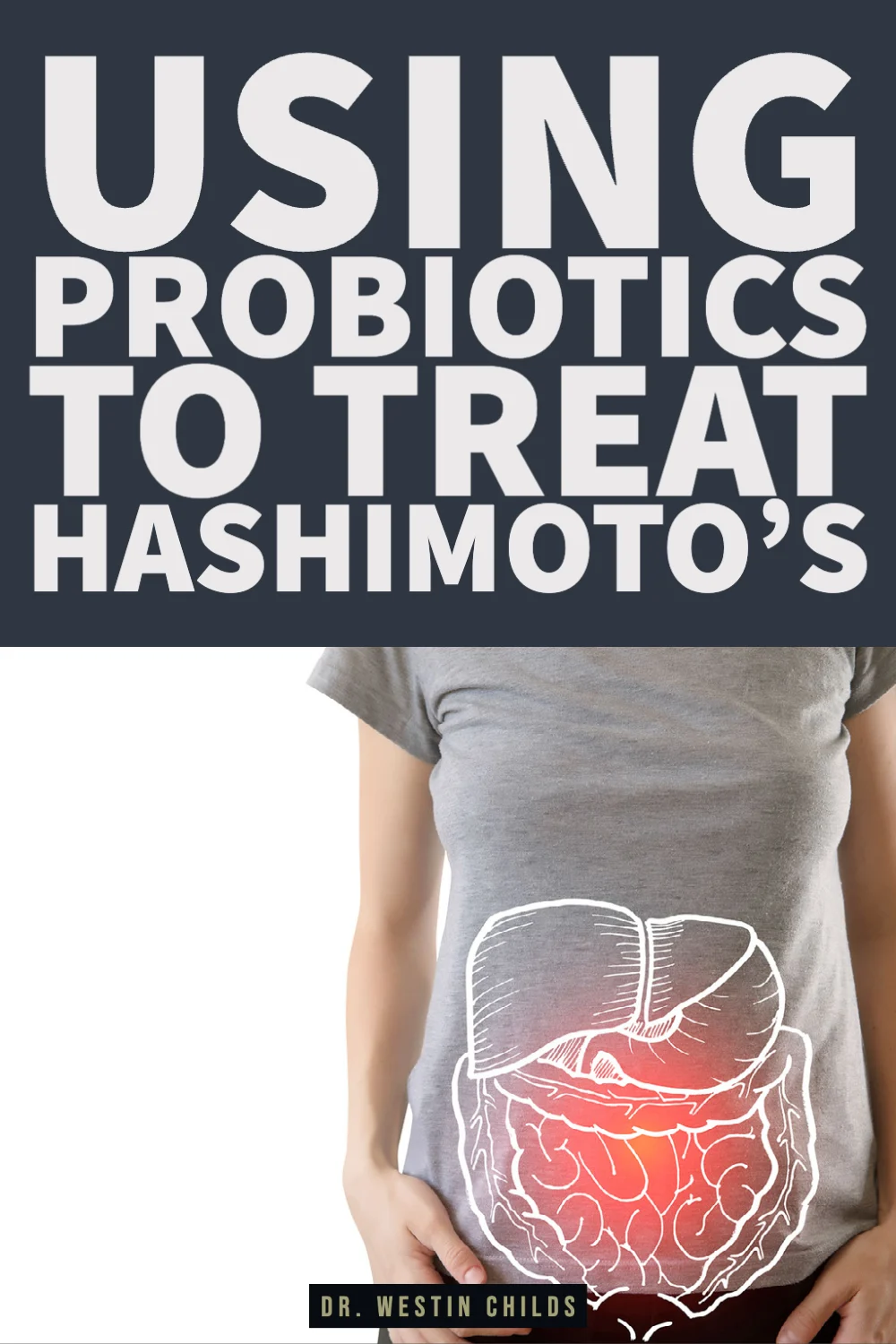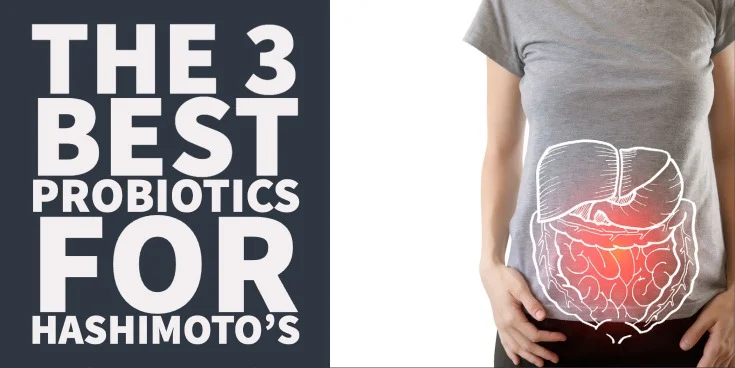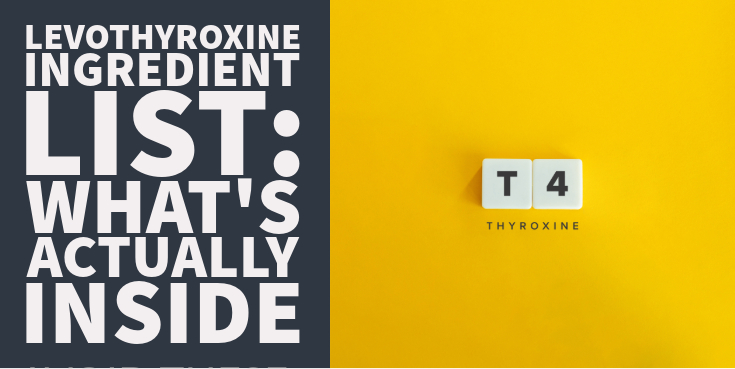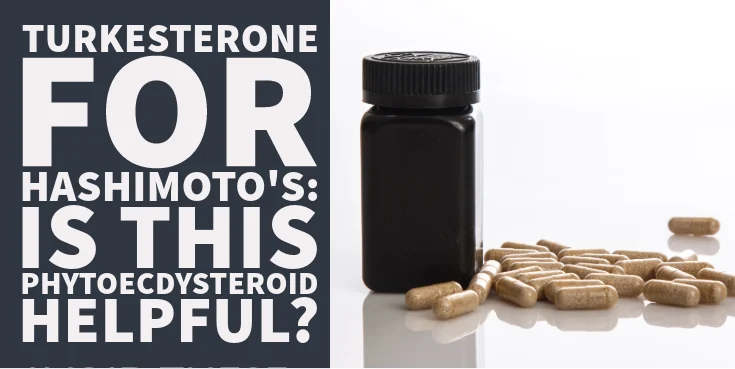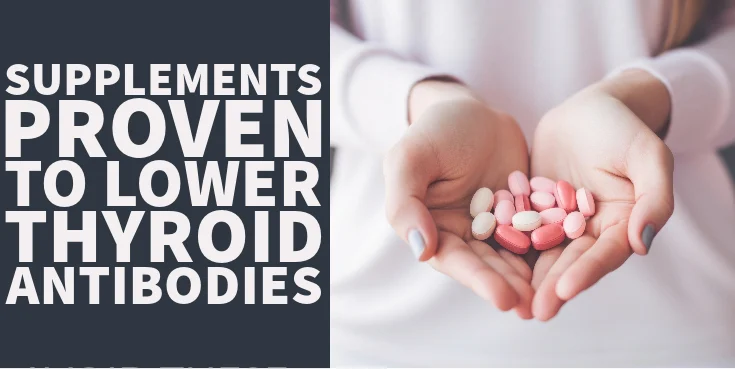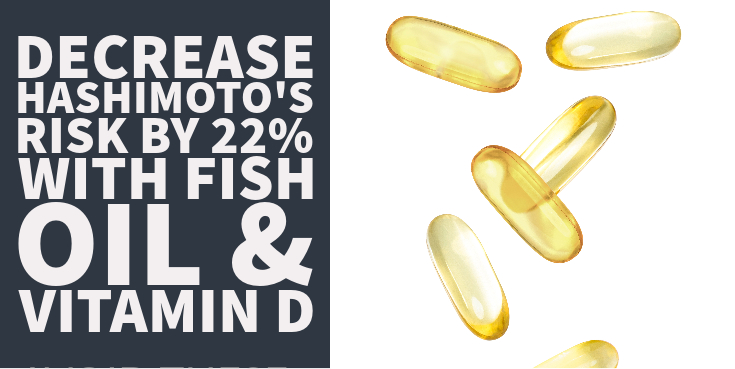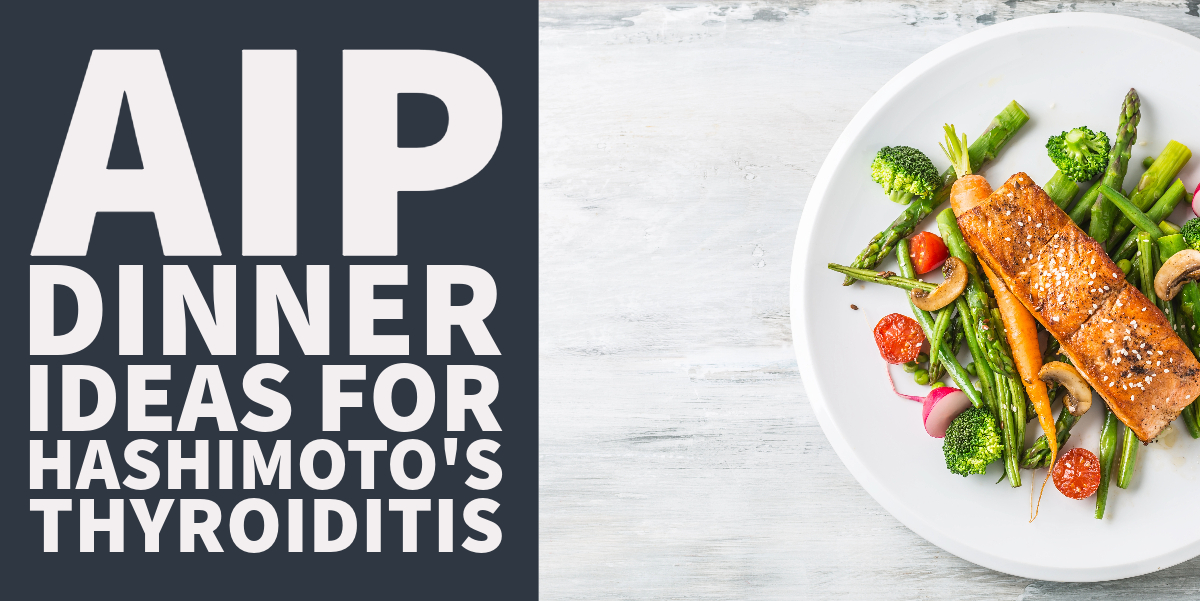I hate to re-hash one of the most overused statements of all time, but I’m going to anyway:
As the saying goes… “all disease begins in the gut”.
Now, don’t take this literally because it’s not true that every disease begins in the gut.
But it’s definitely true that the gut plays a role in just about every major disease that you can think of including (and especially) Hashimoto’s thyroiditis.
If you have this condition, targeting and improving your gut health allows you to drastically improve the course of your disease and dramatically reduce your symptoms.
Does that sound like something that might interest you as a patient with this so-called progressive and uncurable (debatable) disease?
I would think so.
I don’t think I need to convince you that better gut health equals better thyroid health so I won’t spend much time there.
But what I do want to try to do is convince you that taking probiotics each and every day may be the single easiest and (perhaps) most effective way to improve your gut health.
Ok, maybe changing your diet is the MOST effective way to improve your gut health but taking probiotics is definitely easier and faster!
In case you’re not on board with this idea quite yet, let’s take a quick look at just how important gut health is for your thyroid health.
DOWNLOAD FREE RESOURCES
Foods to Avoid if you Have Thyroid Problems:
I’ve found that these 10 foods cause the most problems for thyroid patients. Learn which foods you should avoid if you have thyroid disease of any type.
The Complete List of Thyroid Lab tests:
The list includes optimal ranges, normal ranges, and the complete list of tests you need to diagnose and manage thyroid disease correctly!
Why Gut Health Matters in Hashimoto’s
For starters, your gut is…
- A major site of T4 to T3 conversion: Roughly 20% of all T3 that circulates in your body (1) is created in your gut. If this area is compromised by chronic inflammation you better believe that your T3 production will be as well.
- The place where thyroid medication is absorbed: What good does thyroid medication do if you are only absorbing a fraction of the amount that you take by mouth? This is far more common than you might think which is why so many thyroid patients feel terrible even while taking thyroid medication daily.
- A major site of immune regulation and balance: Roughly 70% of your immune cells are found in the gut (2). If you are experiencing gut-related symptoms then those cells may not be doing their job adequately.
- A barrier to the outside world which, when compromised, may trigger autoimmune disease: If the intestinal lining of your gut gets damaged (so-called leaky gut), food and bacterial particles can get absorbed into your bloodstream where they can interact with your immune system (3) leading to autoimmune disease. Hashimoto’s may be triggered by this very mechanism!
- The site of nutrient absorption: The nutrients that your thyroid needs to function are all absorbed in the gut via supplements or food. If your gut is damaged, you may end up with multiple nutrient deficiencies that will negatively impact your thyroid.
It’s pretty easy to see why there is such a strong connection between your gut and the function of other tissues in your body, including your thyroid.
This is why so many people spend so much time trying to heal their gut.
They are aiming for benefits like these:
- Better thyroid antibody control (including a decline in thyroid peroxidase and thyroglobulin antibodies)
- Better thyroid symptom control (both hyper and hypo)
- Fewer gastrointestinal symptoms like constipation, diarrhea, bloating, etc.
- Better looking skin
- Better mood control
- Better sleep
- Better digestion
- And so much more
If these sound appealing to you as a patient with autoimmune thyroid disease (and they should), then let’s talk about how to heal your gut by using probiotics.
The 3 Strains You Want to Look For
I’m sure you’re very familiar with probiotics as a treatment option but you may not be as familiar with how they work.
This is probably because researchers and scientists are still trying to figure that out, so don’t feel bad if this information is all new to you.
So what are probiotics?
They are live species of bacteria that you can take in powder or liquid form that are meant to have a positive interaction with your microbiome.
Your microbiome, of course, is the sum total of bacteria (estimated at around 100 trillion (4)) living in your gut and interacting with your body and cells.
Changes to the concentration and the types or species of bacteria in your microbiome can have a profound impact on your overall health.
If you are like most people then you probably assume that probiotics contain healthy bacteria that are meant to populate and live inside of your intestinal tract once you take them.
But that’s typically not how they work.
Instead, they are really just passengers along for the ride down your intestinal tract where they interact with the cells and bacteria in your gut before they are shipped out via the stool.
And we know that not all of these probiotics are created equal.
Some have different benefits over others which means there’s a lot of variation in the supplements that you can take.
But if you are a patient with Hashimoto’s thyroiditis, these are the three types of probiotics you’ll want to look for.
#1. Soil-Based Organisms
Soil-based organisms are a special and unique class of probiotics that are much different from the standard probiotics.
Unlike standard probiotics, these species are incredibly hardy and can withstand extreme temperatures and extreme conditions.
This is important because most probiotic species are considered to be very fragile.
In fact, many species are so fragile that small changes in temperature or pH cause them to prematurely die off.
This is why you’ll often see probiotics transported with ice (to control the temperature) or formulated with special capsules to try and prevent death in the stomach from stomach acid.
You don’t have to worry about either of these things when taking soil-based probiotics.
So where do they come from?
As the name implies, they are from the soil.
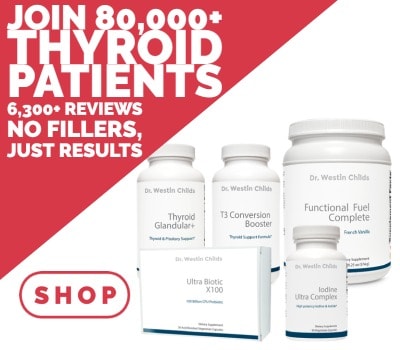
As humans, we used to come into contact with these organisms frequently with the harvesting of foods and with the use of well water.
But because we no longer drink well water and because we no longer hand harvest our own foods, our exposure to these organisms is much more limited now than it used to be.
This is problematic because it’s felt that our microbiome evolved in conjunction with these organisms.
The good news is you don’t have to drink well water or harvest your own food by hand to get them.
Nowadays, you can get them in specific probiotic formulas.
It’s worth pointing out that not all soil-based organisms are considered to be safe as some have been shown to cause human disease.
This isn’t a concern, though, as long as you stick to the species that are known to be helpful and not harmful.
These species include:
- Bacillus clausii
- Bacillus coagulans
- Bacillus subtilis
There are a few things to know about soil-based organisms before using them:
- Unlike most of the probiotic species we will discuss here, soil-based organisms do populate your gastrointestinal tract and stay in your system long-term making them unique in more ways than one.
- You don’t need massive doses of soil-based organisms to see a big benefit. Doses in the 5 to 10 billion CFU range are more than sufficient to provide positive benefits (but higher doses can be even more beneficial).
- Like any probiotic, using multiple species at once is always ideal.
Soil-based organisms are backed by plenty of research studies showing their safety and benefits (5) in treating conditions like constipation, diarrhea, H. pylori, IBS, and more.
#2. Beneficial Yeast (Saccharomyces Boulardiii)
Next on the list is the beneficial yeast known as Saccharomyces boulardii.
Don’t let this one confuse you.
When people hear the word yeast they get freaked out and associate it with the pathogenic yeast known as candida.
This is NOT the same thing as candida!
It’s also NOT the same thing as baker’s yeast!
Saccharomyces boulardii is a beneficial and healthy yeast that acts more like a probiotic (6) than a yeast.
It’s particularly helpful for patients with Hashimoto’s because it happens to target and balances the problems that lead to autoimmune disease in the gut.
It works in several different ways:
- The first is by helping your body eliminate pathogenic organisms like infectious yeast, bacteria, and even parasites.
- The second is by positively impacting the immune system by raising an immunoglobulin known as IgA.
- And the third is by helping to stimulate the growth and repair of intestinal cells.
When you look at the gut problems that patients with Hashimoto’s patients face, this beneficial yeast is helpful for every single one.
This includes conditions like H. pylori, Candida (fungal overgrowth), small intestinal bacterial overgrowth, infectious parasites (blastocystic hominis), and irritable bowel syndrome.
Saccharomyces boulardii is usually found as a stand-alone probiotic so you may need to purchase it separately, but it can be combined with all o the probiotic species we are discussing today.
#3. Bifidobacterium and Lactobacillus Strains (Multiple Types)
Finally, the last set of probiotic species to look for includes the bifidobacterium and lactobacillus strains.
These are very well-known and well-researched strains (7) that are included at baseline in most probiotics.
They are often lumped together because there are so many different species and they work synergistically when taken together.
If you want to get really nitty gritty, you can drill down into the research and find benefits from individual strains (8) but I don’t think that’s the best way to look at these species.
Instead of looking at individual strains and their individual benefits, I think it makes a lot more sense to think about them as a combination therapy.
When combined, they provide a broad range of positive impacts on gut health and, therefore, a broad range of benefits for your body and thyroid.
It may sound good in theory to try and pinpoint the exact species that will benefit your gut based on what you are missing, but it turns out that this approach doesn’t work as well as you might think.
Instead of trying to find exactly what your gut needs, the best approach appears to be taking several different probiotic species and strains all at once.
Some of my favorite lacto and bifido species include:
- L. acidophilus
- B. bifidum
- L. casei
- B. lactis
- B. longum
- L. plantarum
- L. rhamnosus
- L. brevis
These probiotic species have a strong but short-lived positive benefit on the GI tract which means they need to be taken continuously.
When using lacto and bifido strains, my recommendation is to use at least 8+ species at once and get at least 10+ billion CFU/serving.
If you are just using the bifido and lacto strains then you will likely need a much higher CFU/serving dose, but if you combine them with beneficial yeast and soil-based organisms, you can get by with a much smaller dose.
The easiest way to get all of these species at the same time is to use a 3-in-1 probiotic like this one.
If you prefer, you can also purchase each type of probiotic individually and take three separate probiotic supplements to get everything mentioned above.
And don’t forget that you will definitely need to do more than just take probiotics to heal your gut.
You can heal your gut even faster by eating foods designed to naturally increase a compound called butyrate.
You can learn more about how to do that in this article.
Recap
- Treating your gut is a quick and easy way to improve your thyroid if you have Hashimoto’s.
- One of the easiest ways to treat (heal) your gut is with the use of certain probiotics.
- The three best types of probiotics for patients with Hashimoto’s include soil-based organisms, beneficial yeast, and bifido and lactobacillus strains. This triple combination provides both short-term and long-term benefits to the intestinal tract.
- For best results, take these probiotics and combine them with natural sources of fiber and prebiotics from whole foods.
Now I want to hear from you:
Were you aware of the connection between your gut, immune system, and thyroid?
Are you taking steps to heal your gut?
Are you already taking probiotics? Are you using the species mentioned in this article?
Are you planning on taking probiotics after reading this?
Leave your questions or comments below!
Scientific References
#1. pubmed.ncbi.nlm.nih.gov/32545596/
#2. pubmed.ncbi.nlm.nih.gov/33803407/
#3. ncbi.nlm.nih.gov/pmc/articles/PMC7767453/
#4. bmj.com/content/361/bmj.k2179
#5. pubmed.ncbi.nlm.nih.gov/11365013/
#6. ncbi.nlm.nih.gov/pmc/articles/PMC7344949/
#7. ods.od.nih.gov/factsheets/Probiotics-HealthProfessional/
#8. ncbi.nlm.nih.gov/pmc/articles/PMC8712437/
